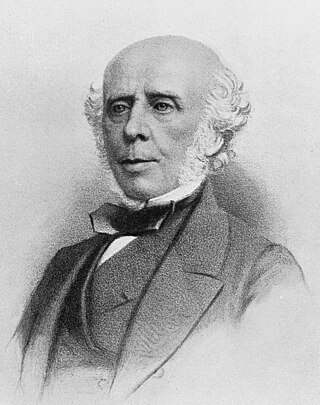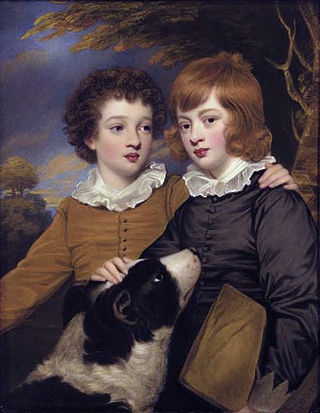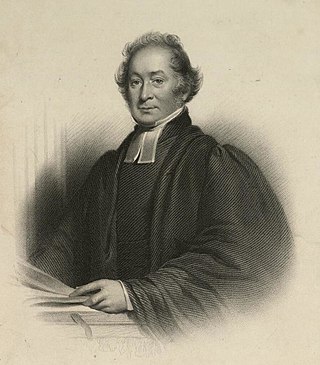
James Kendrick (1809-1882) was an English physician and antiquary.

James Kendrick (1809-1882) was an English physician and antiquary.
Born in Warrington, which then was in Lancashire, on 7 November 1809, he was the son of the physician James Kendrick (1771–1847). He graduated M.D. at Edinburgh on 1 August 1833, and then built up a large medical practice in Warrington. [1]
Kendrick frequently lectured on local topography and history. In 1853 he became a member of the British Archæological Association. In 1859 he took charge of the antiquities in the Warrington Museum, and added to the collection. He forwarded the excavations at the Roman station at Wilderspool, near Warrington, which (with Dr. Robson) he thought might be the Condate of Antonine. [1]
Kendrick had the idea to provide work and assistance for itinerant labourers by providing stone benches on which they could rest while travelling. Around 30 were installed between Liverpool and Manchester in the 1860s and around 12 still survive. Several now have Grade II listed status. [2]
Kendrick died at Warrington 6 April 1882. [1]
Kendrick gave the Museum remains discovered at Wilderspool. After his death, his daughter also handed over to the museum his collection of ecclesiastical and medieval seals and his bequest of one hundred volumes. He gave more than three hundred books bearing a Warrington imprint to the public library. [1]
Kendrick wrote the following books: [1]
Papers by Kendrick appeared in the publications of the Historic Society of Lancashire and Cheshire, Chester Archæological Society, The Reliquary, and Warrington Guardian. A memoir of him in the Palatine Note-Book (ii. 113–16, 179–80) gives a list of his writings, including contributions to newspapers and antiquarian periodicals. [1]
Kendrick was married three times. [1]
![]() This article incorporates text from a publication now in the public domain : Lee, Sidney, ed. (1892). "Kendrick, James". Dictionary of National Biography . Vol. 30. London: Smith, Elder & Co.
This article incorporates text from a publication now in the public domain : Lee, Sidney, ed. (1892). "Kendrick, James". Dictionary of National Biography . Vol. 30. London: Smith, Elder & Co.

Stockton Heath is a civil parish and suburb of Warrington, in the Borough of Warrington, Cheshire, England. It is located to the north of the Bridgewater Canal and to the south of the Manchester Ship Canal, which divides Stockton Heath from Latchford and north Warrington. It has a total resident population of 6,396.

James Theodore Bent was an English explorer, archaeologist, and author.

William Mackenzie was a Scottish ophthalmologist. He wrote Practical Treatise of the Diseases of the Eye, one of the first British textbooks of ophthalmology.

John Bellenden Ker was an English botanist, born about 1764, Ramridge, Andover, Hampshire, which was where he died in June 1842. On 5 November 1804, he changed his name to Ker Bellenden, but continued to sign his name as Bellenden Ker until his death. He was an unsuccessful claimant to the Roxburghe dukedom. His son was legal reformer Charles Henry Bellenden Ker.

Thomas Garnett was an English physician and natural philosopher.
Philip Holland was an English nonconformist minister.

Latham of Bradwall is a family whose seat was at Bradwall Hall, in the township of Bradwall, near Sandbach, England, with several notable members. The line is "a junior branch of the ancient Cheshire house of Lathom, of Lathom and Knowsley, which terminated in the heiress, Isabella Latham, who married Sir John Stanley, Knt., ancestor of the Earls of Derby".
Edward Kennion (1744–1809) was an English artist, initially a soldier and businessman.
William M. Wilson (1799–1871) was an English botanist, known for his focus on bryology.
Joseph John Scoles (1798–1863) was an English Gothic Revival architect, who designed many Roman Catholic churches.

Warrington is an industrial town in the borough of the same name in Cheshire, England. The town sits on the banks of the River Mersey and is historically part of Lancashire. It is 19 miles (31 km) east of Liverpool, and 18 miles (29 km) west of Manchester.

John Parsons Earwaker (1847–1895) was an English antiquary.
Abraham Hume (1814–1884) was a Scots-Irish Anglican priest in Liverpool, known as a social researcher, supporter of learned societies, and antiquary,
Charles Jackson (1809–1882) was an English banker and antiquary.
John Fitchett Marsh was an English solicitor, official and antiquary.

Thomas Raffles was an English Congregational minister, known as a dominant nonconformist figure at the Great George Street Congregational Church in Liverpool, and as an abolitionist and historian.
Thomas William Shore, sometimes given as William Thomas Shore was an English geologist and antiquarian.
James Christopher Scholes was an English antiquary.
Ebenezer Henderson was a Scottish historian and science writer. His major work was The Annals of Dunfermline.
James Hunter Lane, sometimes called Hunter Lane, was a Scottish physician, surgeon and medical writer.